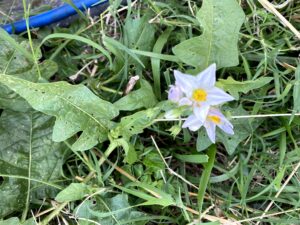Horsenettle – Weed ID Wednesday
go.ncsu.edu/readext?809038
en Español / em Português
El inglés es el idioma de control de esta página. En la medida en que haya algún conflicto entre la traducción al inglés y la traducción, el inglés prevalece.
Al hacer clic en el enlace de traducción se activa un servicio de traducción gratuito para convertir la página al español. Al igual que con cualquier traducción por Internet, la conversión no es sensible al contexto y puede que no traduzca el texto en su significado original. NC State Extension no garantiza la exactitud del texto traducido. Por favor, tenga en cuenta que algunas aplicaciones y/o servicios pueden no funcionar como se espera cuando se traducen.
Português
Inglês é o idioma de controle desta página. Na medida que haja algum conflito entre o texto original em Inglês e a tradução, o Inglês prevalece.
Ao clicar no link de tradução, um serviço gratuito de tradução será ativado para converter a página para o Português. Como em qualquer tradução pela internet, a conversão não é sensivel ao contexto e pode não ocorrer a tradução para o significado orginal. O serviço de Extensão da Carolina do Norte (NC State Extension) não garante a exatidão do texto traduzido. Por favor, observe que algumas funções ou serviços podem não funcionar como esperado após a tradução.
English
English is the controlling language of this page. To the extent there is any conflict between the English text and the translation, English controls.
Clicking on the translation link activates a free translation service to convert the page to Spanish. As with any Internet translation, the conversion is not context-sensitive and may not translate the text to its original meaning. NC State Extension does not guarantee the accuracy of the translated text. Please note that some applications and/or services may not function as expected when translated.
Collapse ▲Horsenettle is in the nightshade family, making it related to tomatoes and potatoes. While not nearly as delicious as its relatives, horsenettle can be problematic in hayfields and pastures. It is an herbaceous perennial that can grow up to 3 ft tall, has prickly leaves, small white or pale violet flowers in clusters, and produces berries.
Horsenettle does not taste good to livestock, so they usually will not consume it and spend too much time picking around it in grazing pastures and in baled hay. This reduces our cattle’s feeding efficiency because they are spending too much time looking for the grass or hay around the horsenettle, instead of just being able to eat it. Horsenettle is toxic to livestock and the prickly leaves can cause issues in the mouth and esophagus. While they usually do not consume it, the chances of issues are higher in pastures that are overgrazed and have low availability of grass. They are better at avoiding it when they have plenty of more desirable forages to choose from.
Because of its prickly presence and wanting to limit the opportunity for consumption, looking at control methods for horsenettle is a common conversation.
Horsenettle is commonly spread to new pastures by feeding hay with horsenettle baled in with the grass. If possible, buy clean hay and continue to monitor for weed presence around feeding areas, including hay rings. Fence lines and working areas are common culprits as well. Scout these areas heavily and plan to keep it from spreading to the rest of the pasture.
Repeatedly mowing or clipping horsenettle will suppress growth but will not result in control.
A timely application of a recommended herbicide is the most effective form of control for horsenettle. According to a research article from the University of Tennesee- “Several herbicides such as 2,4-D, Banvel/Oracle (dicamba), and Rangestar/Weedmaster (2,4-D + dicamba) will give various degrees of weed top kill but they do little to the roots and rhizomes. Currently, the University of Tennessee recommends Milestone (aminopyralid) or ForeFront (aminopyralid + 2,4-D), or Grazon P+D (picloram + 2,4-D) in approved counties. Grazon P+D is a restricted-use herbicide. University of Tennessee research has shown that the optimum time for application of these herbicides is at the flowering stage, prior to formation of berries”. Read this Pasture Weed Fact Sheet for more information. Be sure to read the label in full for any product you may choose to use.







